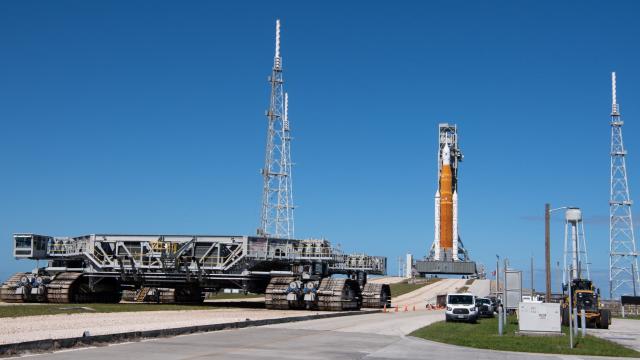NASA’s Kennedy Space Centre in Florida has entered into a hurricane preparedness mode as Subtropical Storm Nicole threatens the peninsula. At the same time, the space agency says its 97.84 m-tall SLS rocket will remain at the launch pad — at least for now.
NOAA is currently tracking Nicole, saying the storm will produce heavy rains by Wednesday night and Thursday across the Florida peninsula, and it’s projecting the arrival of tropical storm-force winds at Kennedy Space Centre by Wednesday morning. So by the looks of it, Florida is about to experience a late-season Category 1 hurricane.
In anticipation of Nicole, NASA’s Kennedy Space Centre has entered into HURCON IV status, a hurricane preparedness mode that kicks in 72 hours prior to the arrival of 93 km-per-hour (94 kilometre-per-hour) sustained winds. This hurricane condition alert level includes “implementing organisation-specific check-lists,” ensuring all vehicles are fully fuelled, and confirming Rideout Team (ROT) personnel.
Kennedy Space Centre may be in HURCON IV mode, but its gigantic rocket, with the Orion spacecraft nestled up top, isn’t going anywhere, at least not yet. NASA transported the Space Launch System to Launch Pad 39B on Friday in anticipation of a launch on early Monday morning.
In a brief statement issued this afternoon, NASA said that, “based on current forecast data,” mission managers have decided to keep SLS and Orion on the pad and not move it back to the nearby Vehicle Assembly Building for shelter. “Teams at Kennedy will continue to monitor the weather, make sure all personnel are safe, and will evaluate the status of the Monday…launch attempt for the Artemis 1 mission as we proceed and receive updated predictions about the weather.”
For NASA, it’s deja vu. The space agency was ready to launch the 5.75-million-pound SLS on September 27, but Hurricane Ian sent the rocket back to the VAB. In the days leading up to the rollback, however, managers waited until Ian’s potential trajectory was more obvious. In this case, Nicole’s trajectory is likewise uncertain, as it could “move inland across portions of the Florida peninsula” or “turn northward near or along the east coast of Florida,” as Michael Brennan, National Hurricane Centre’s acting director, told the Orlando Sentinel. Alternately, Nicole “could remain just offshore and move more toward the Georgia and Carolina coasts,” he added.
In addition to knowing the hurricane’s path, NASA officials will want an accurate assesment of the storm’s winds. SLS can withstand 137 km-per-hour (137-kilometre-per-hour) wind gusts at the pad, while rollback can withstand sustained winds reaching 46 mph (74 kph).
The upcoming Artemis missions are meant to return NASA to the Moon after a 50-year absence. For the Artemis 1 mission, the space agency will launch its SLS rocket for the first time and send an uncrewed Orion on a 25-day mission around the Moon and back, setting the stage for a nearly identical crewed mission in 2024.
